UUNZ PG - Organizational Behaviour: Tsunami Relief Mission Analysis
VerifiedAdded on 2023/04/19
|20
|4867
|321
Essay
AI Summary
This essay delves into the complexities of organizational behaviour within the context of a humanitarian aid mission responding to the tsunami devastation in Indonesia. It explores the foundations of individual behaviour and its impact on work organizations, particularly focusing on a team comprising members from diverse cultural backgrounds, including six Māori team members. The essay analyzes stages of team development (forming, storming, norming, performing, and adjourning) and identifies communication barriers arising from cultural differences, stereotypes, and varying perceptions. Strategies for resolving these barriers, such as setting clear expectations, respecting personal differences, and defusing personality conflicts, are discussed. Furthermore, the essay examines motivation theories, including Maslow's hierarchy of needs, and their relevance to enhancing work performance and employee outcomes within the mission. The role of communication in fostering a positive and productive work environment is also emphasized, along with the cultural dimension of indulgence versus restraint.
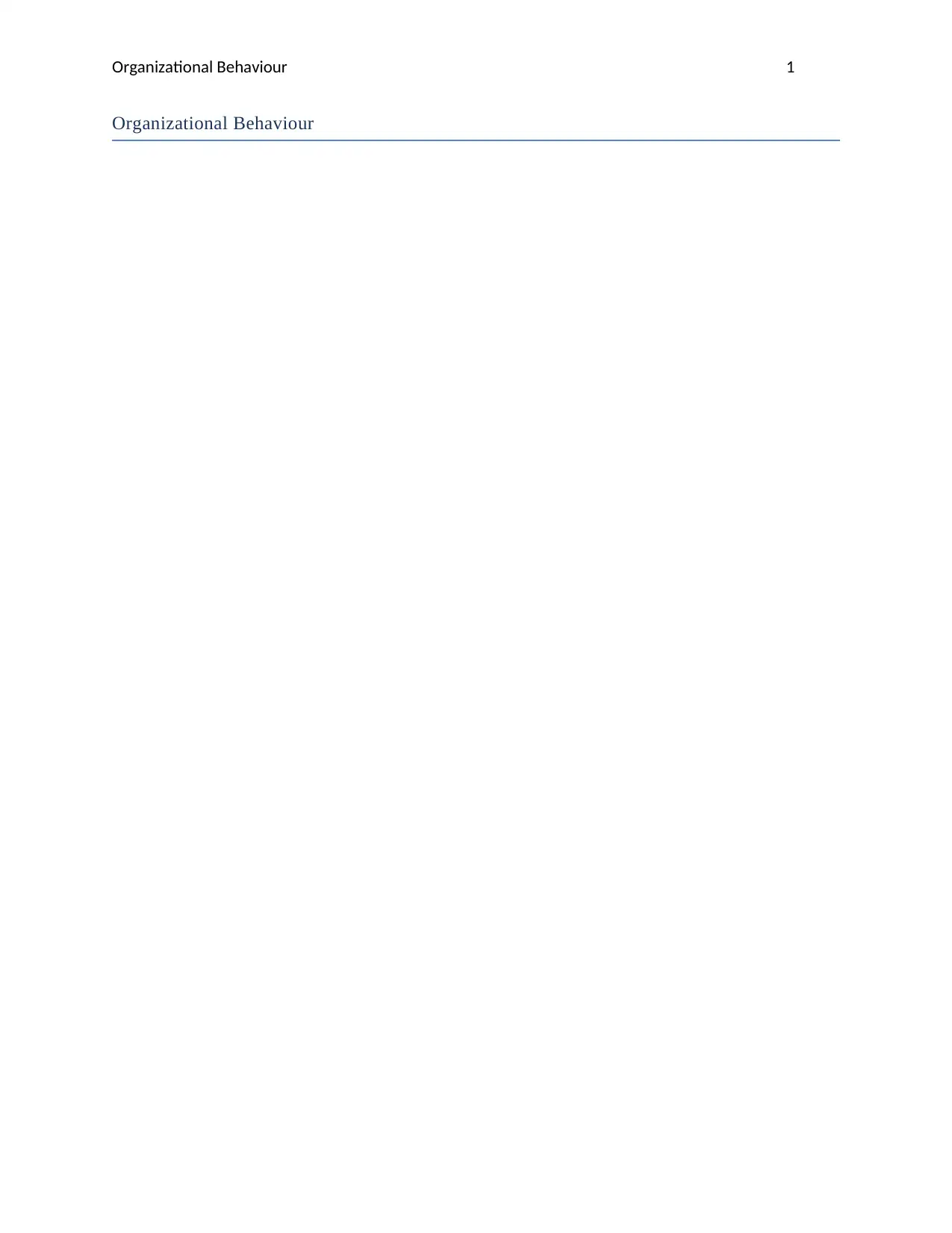
Organizational Behaviour 1
Organizational Behaviour
Organizational Behaviour
Paraphrase This Document
Need a fresh take? Get an instant paraphrase of this document with our AI Paraphraser
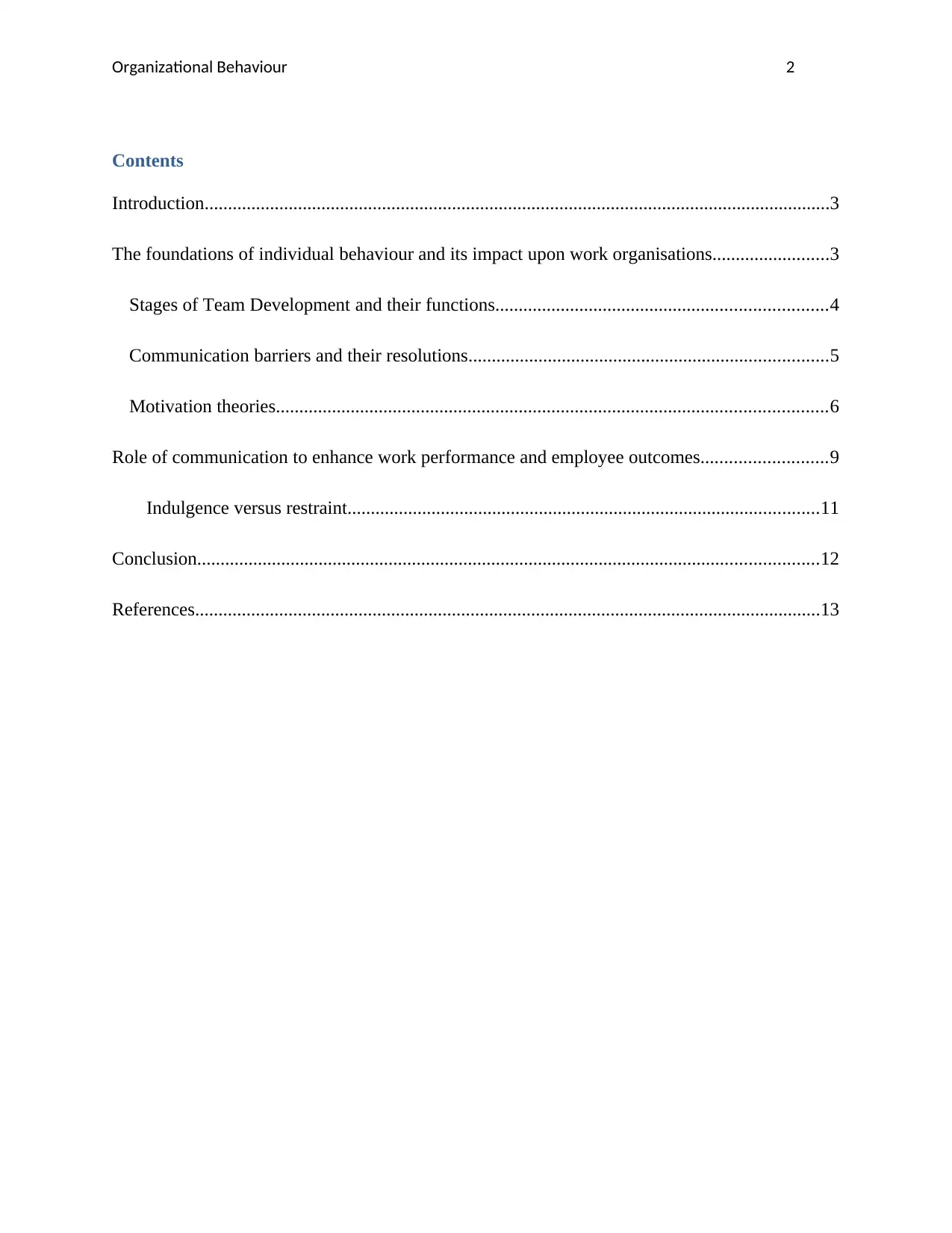
Organizational Behaviour 2
Contents
Introduction......................................................................................................................................3
The foundations of individual behaviour and its impact upon work organisations.........................3
Stages of Team Development and their functions.......................................................................4
Communication barriers and their resolutions.............................................................................5
Motivation theories......................................................................................................................6
Role of communication to enhance work performance and employee outcomes...........................9
Indulgence versus restraint.....................................................................................................11
Conclusion.....................................................................................................................................12
References......................................................................................................................................13
Contents
Introduction......................................................................................................................................3
The foundations of individual behaviour and its impact upon work organisations.........................3
Stages of Team Development and their functions.......................................................................4
Communication barriers and their resolutions.............................................................................5
Motivation theories......................................................................................................................6
Role of communication to enhance work performance and employee outcomes...........................9
Indulgence versus restraint.....................................................................................................11
Conclusion.....................................................................................................................................12
References......................................................................................................................................13
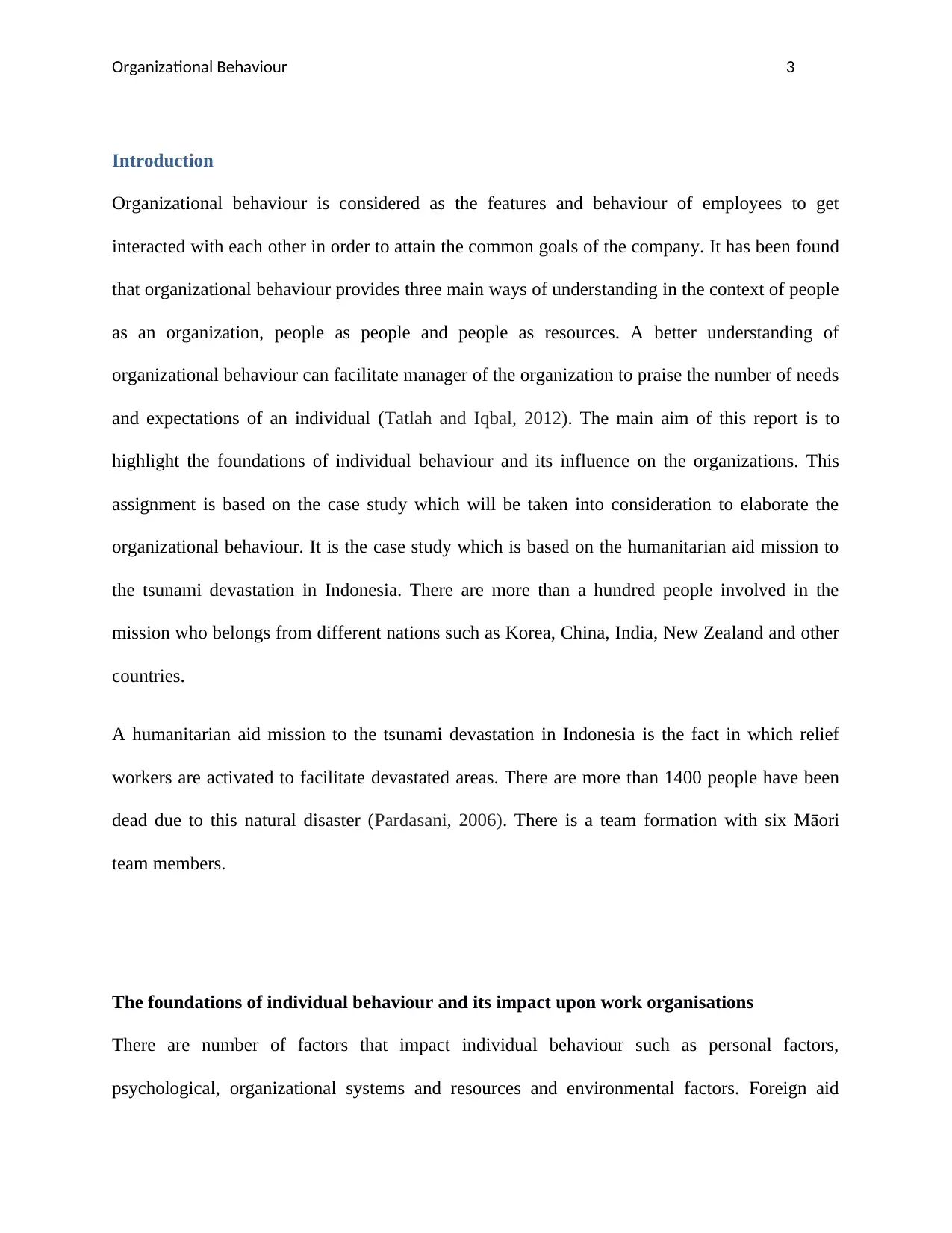
Organizational Behaviour 3
Introduction
Organizational behaviour is considered as the features and behaviour of employees to get
interacted with each other in order to attain the common goals of the company. It has been found
that organizational behaviour provides three main ways of understanding in the context of people
as an organization, people as people and people as resources. A better understanding of
organizational behaviour can facilitate manager of the organization to praise the number of needs
and expectations of an individual (Tatlah and Iqbal, 2012). The main aim of this report is to
highlight the foundations of individual behaviour and its influence on the organizations. This
assignment is based on the case study which will be taken into consideration to elaborate the
organizational behaviour. It is the case study which is based on the humanitarian aid mission to
the tsunami devastation in Indonesia. There are more than a hundred people involved in the
mission who belongs from different nations such as Korea, China, India, New Zealand and other
countries.
A humanitarian aid mission to the tsunami devastation in Indonesia is the fact in which relief
workers are activated to facilitate devastated areas. There are more than 1400 people have been
dead due to this natural disaster (Pardasani, 2006). There is a team formation with six Māori
team members.
The foundations of individual behaviour and its impact upon work organisations
There are number of factors that impact individual behaviour such as personal factors,
psychological, organizational systems and resources and environmental factors. Foreign aid
Introduction
Organizational behaviour is considered as the features and behaviour of employees to get
interacted with each other in order to attain the common goals of the company. It has been found
that organizational behaviour provides three main ways of understanding in the context of people
as an organization, people as people and people as resources. A better understanding of
organizational behaviour can facilitate manager of the organization to praise the number of needs
and expectations of an individual (Tatlah and Iqbal, 2012). The main aim of this report is to
highlight the foundations of individual behaviour and its influence on the organizations. This
assignment is based on the case study which will be taken into consideration to elaborate the
organizational behaviour. It is the case study which is based on the humanitarian aid mission to
the tsunami devastation in Indonesia. There are more than a hundred people involved in the
mission who belongs from different nations such as Korea, China, India, New Zealand and other
countries.
A humanitarian aid mission to the tsunami devastation in Indonesia is the fact in which relief
workers are activated to facilitate devastated areas. There are more than 1400 people have been
dead due to this natural disaster (Pardasani, 2006). There is a team formation with six Māori
team members.
The foundations of individual behaviour and its impact upon work organisations
There are number of factors that impact individual behaviour such as personal factors,
psychological, organizational systems and resources and environmental factors. Foreign aid
⊘ This is a preview!⊘
Do you want full access?
Subscribe today to unlock all pages.

Trusted by 1+ million students worldwide
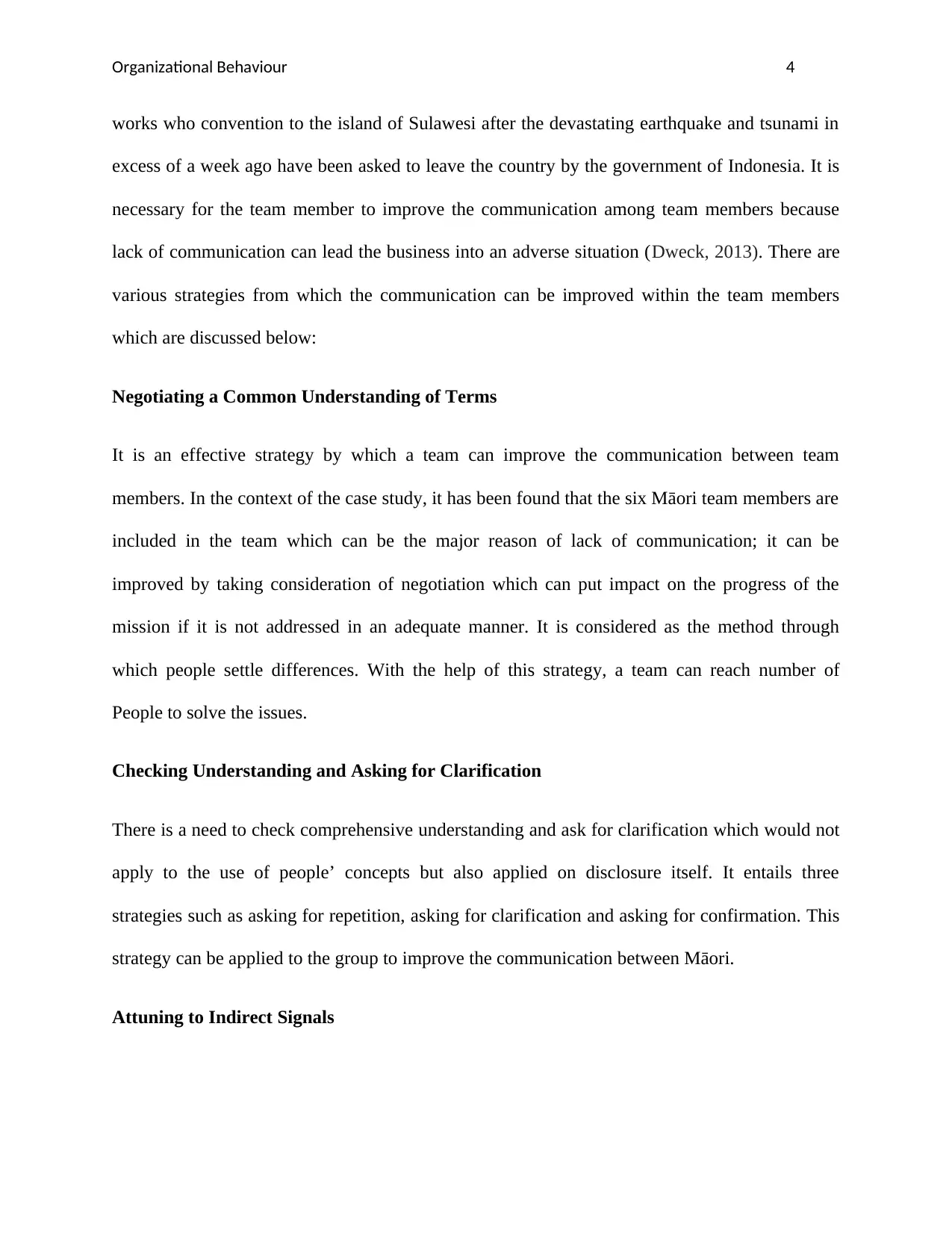
Organizational Behaviour 4
works who convention to the island of Sulawesi after the devastating earthquake and tsunami in
excess of a week ago have been asked to leave the country by the government of Indonesia. It is
necessary for the team member to improve the communication among team members because
lack of communication can lead the business into an adverse situation (Dweck, 2013). There are
various strategies from which the communication can be improved within the team members
which are discussed below:
Negotiating a Common Understanding of Terms
It is an effective strategy by which a team can improve the communication between team
members. In the context of the case study, it has been found that the six Māori team members are
included in the team which can be the major reason of lack of communication; it can be
improved by taking consideration of negotiation which can put impact on the progress of the
mission if it is not addressed in an adequate manner. It is considered as the method through
which people settle differences. With the help of this strategy, a team can reach number of
People to solve the issues.
Checking Understanding and Asking for Clarification
There is a need to check comprehensive understanding and ask for clarification which would not
apply to the use of people’ concepts but also applied on disclosure itself. It entails three
strategies such as asking for repetition, asking for clarification and asking for confirmation. This
strategy can be applied to the group to improve the communication between Māori.
Attuning to Indirect Signals
works who convention to the island of Sulawesi after the devastating earthquake and tsunami in
excess of a week ago have been asked to leave the country by the government of Indonesia. It is
necessary for the team member to improve the communication among team members because
lack of communication can lead the business into an adverse situation (Dweck, 2013). There are
various strategies from which the communication can be improved within the team members
which are discussed below:
Negotiating a Common Understanding of Terms
It is an effective strategy by which a team can improve the communication between team
members. In the context of the case study, it has been found that the six Māori team members are
included in the team which can be the major reason of lack of communication; it can be
improved by taking consideration of negotiation which can put impact on the progress of the
mission if it is not addressed in an adequate manner. It is considered as the method through
which people settle differences. With the help of this strategy, a team can reach number of
People to solve the issues.
Checking Understanding and Asking for Clarification
There is a need to check comprehensive understanding and ask for clarification which would not
apply to the use of people’ concepts but also applied on disclosure itself. It entails three
strategies such as asking for repetition, asking for clarification and asking for confirmation. This
strategy can be applied to the group to improve the communication between Māori.
Attuning to Indirect Signals
Paraphrase This Document
Need a fresh take? Get an instant paraphrase of this document with our AI Paraphraser
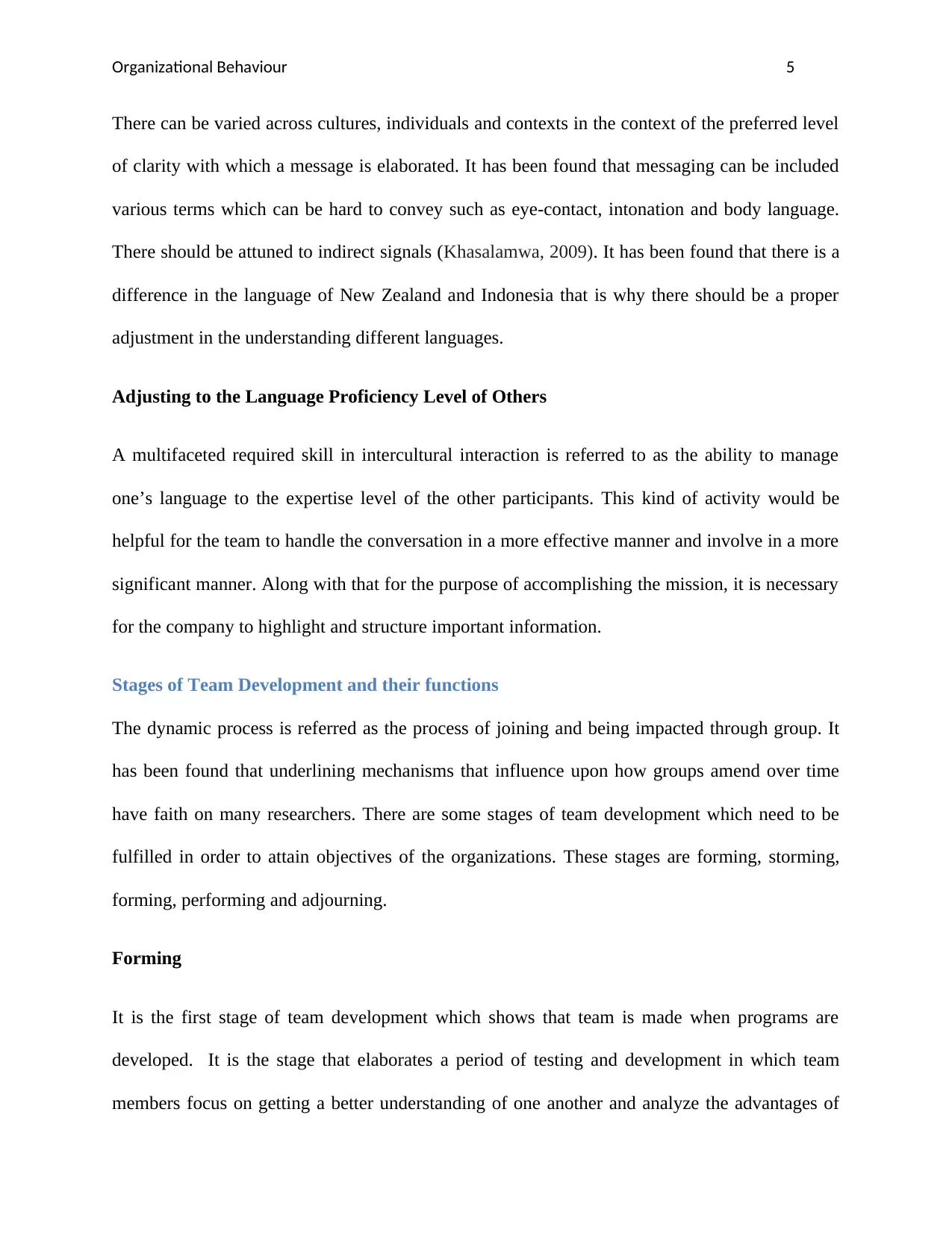
Organizational Behaviour 5
There can be varied across cultures, individuals and contexts in the context of the preferred level
of clarity with which a message is elaborated. It has been found that messaging can be included
various terms which can be hard to convey such as eye-contact, intonation and body language.
There should be attuned to indirect signals (Khasalamwa, 2009). It has been found that there is a
difference in the language of New Zealand and Indonesia that is why there should be a proper
adjustment in the understanding different languages.
Adjusting to the Language Proficiency Level of Others
A multifaceted required skill in intercultural interaction is referred to as the ability to manage
one’s language to the expertise level of the other participants. This kind of activity would be
helpful for the team to handle the conversation in a more effective manner and involve in a more
significant manner. Along with that for the purpose of accomplishing the mission, it is necessary
for the company to highlight and structure important information.
Stages of Team Development and their functions
The dynamic process is referred as the process of joining and being impacted through group. It
has been found that underlining mechanisms that influence upon how groups amend over time
have faith on many researchers. There are some stages of team development which need to be
fulfilled in order to attain objectives of the organizations. These stages are forming, storming,
forming, performing and adjourning.
Forming
It is the first stage of team development which shows that team is made when programs are
developed. It is the stage that elaborates a period of testing and development in which team
members focus on getting a better understanding of one another and analyze the advantages of
There can be varied across cultures, individuals and contexts in the context of the preferred level
of clarity with which a message is elaborated. It has been found that messaging can be included
various terms which can be hard to convey such as eye-contact, intonation and body language.
There should be attuned to indirect signals (Khasalamwa, 2009). It has been found that there is a
difference in the language of New Zealand and Indonesia that is why there should be a proper
adjustment in the understanding different languages.
Adjusting to the Language Proficiency Level of Others
A multifaceted required skill in intercultural interaction is referred to as the ability to manage
one’s language to the expertise level of the other participants. This kind of activity would be
helpful for the team to handle the conversation in a more effective manner and involve in a more
significant manner. Along with that for the purpose of accomplishing the mission, it is necessary
for the company to highlight and structure important information.
Stages of Team Development and their functions
The dynamic process is referred as the process of joining and being impacted through group. It
has been found that underlining mechanisms that influence upon how groups amend over time
have faith on many researchers. There are some stages of team development which need to be
fulfilled in order to attain objectives of the organizations. These stages are forming, storming,
forming, performing and adjourning.
Forming
It is the first stage of team development which shows that team is made when programs are
developed. It is the stage that elaborates a period of testing and development in which team
members focus on getting a better understanding of one another and analyze the advantages of
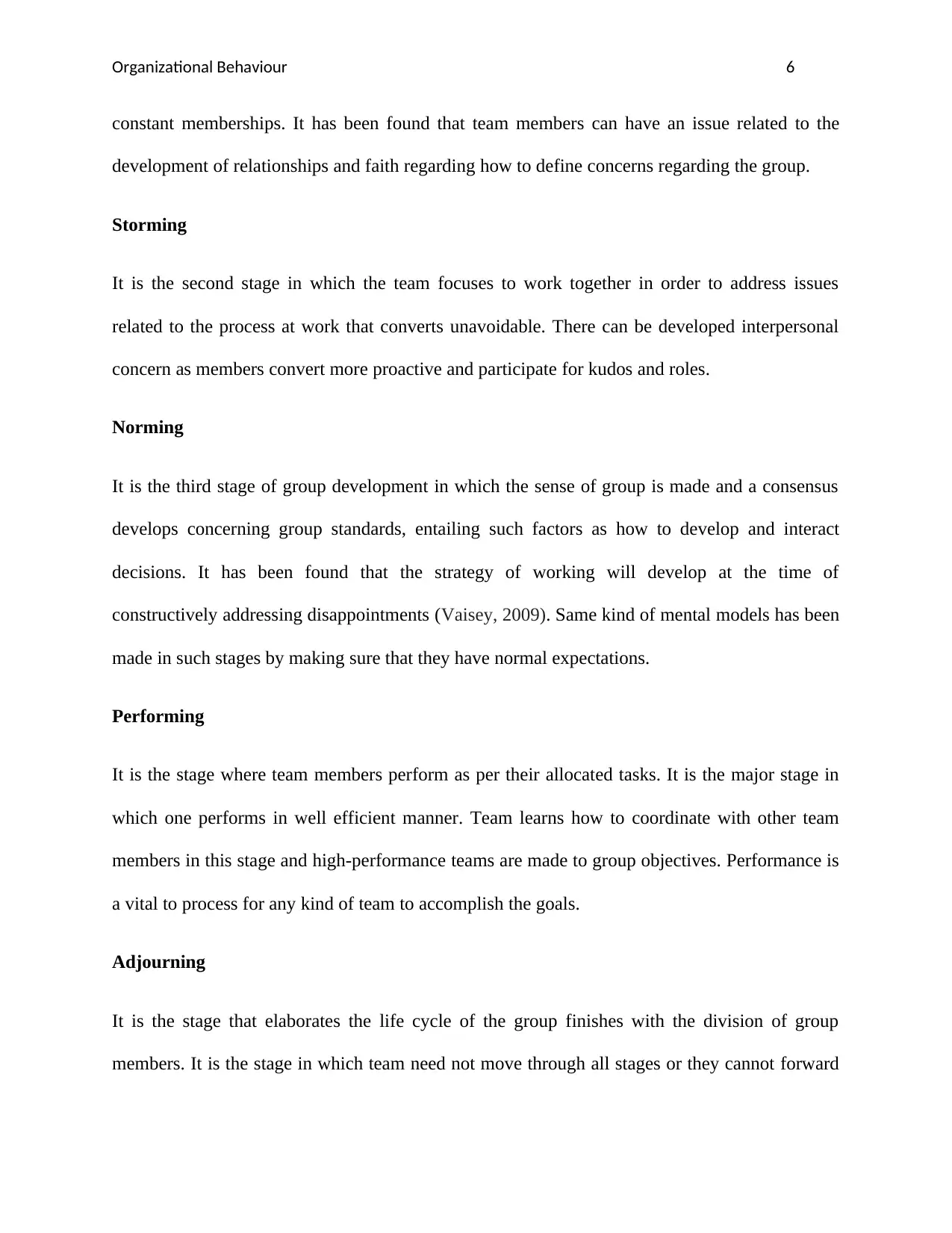
Organizational Behaviour 6
constant memberships. It has been found that team members can have an issue related to the
development of relationships and faith regarding how to define concerns regarding the group.
Storming
It is the second stage in which the team focuses to work together in order to address issues
related to the process at work that converts unavoidable. There can be developed interpersonal
concern as members convert more proactive and participate for kudos and roles.
Norming
It is the third stage of group development in which the sense of group is made and a consensus
develops concerning group standards, entailing such factors as how to develop and interact
decisions. It has been found that the strategy of working will develop at the time of
constructively addressing disappointments (Vaisey, 2009). Same kind of mental models has been
made in such stages by making sure that they have normal expectations.
Performing
It is the stage where team members perform as per their allocated tasks. It is the major stage in
which one performs in well efficient manner. Team learns how to coordinate with other team
members in this stage and high-performance teams are made to group objectives. Performance is
a vital to process for any kind of team to accomplish the goals.
Adjourning
It is the stage that elaborates the life cycle of the group finishes with the division of group
members. It is the stage in which team need not move through all stages or they cannot forward
constant memberships. It has been found that team members can have an issue related to the
development of relationships and faith regarding how to define concerns regarding the group.
Storming
It is the second stage in which the team focuses to work together in order to address issues
related to the process at work that converts unavoidable. There can be developed interpersonal
concern as members convert more proactive and participate for kudos and roles.
Norming
It is the third stage of group development in which the sense of group is made and a consensus
develops concerning group standards, entailing such factors as how to develop and interact
decisions. It has been found that the strategy of working will develop at the time of
constructively addressing disappointments (Vaisey, 2009). Same kind of mental models has been
made in such stages by making sure that they have normal expectations.
Performing
It is the stage where team members perform as per their allocated tasks. It is the major stage in
which one performs in well efficient manner. Team learns how to coordinate with other team
members in this stage and high-performance teams are made to group objectives. Performance is
a vital to process for any kind of team to accomplish the goals.
Adjourning
It is the stage that elaborates the life cycle of the group finishes with the division of group
members. It is the stage in which team need not move through all stages or they cannot forward
⊘ This is a preview!⊘
Do you want full access?
Subscribe today to unlock all pages.

Trusted by 1+ million students worldwide
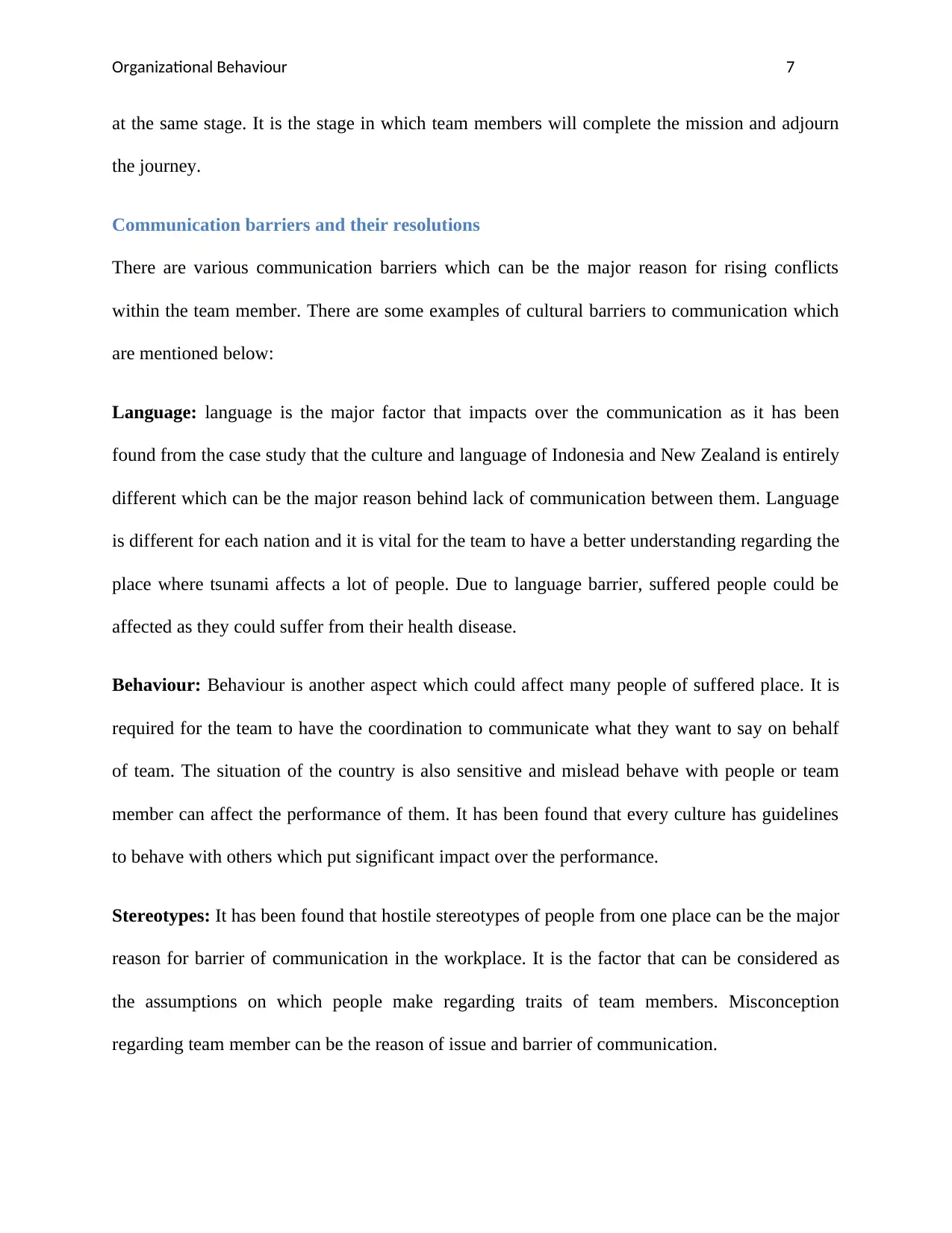
Organizational Behaviour 7
at the same stage. It is the stage in which team members will complete the mission and adjourn
the journey.
Communication barriers and their resolutions
There are various communication barriers which can be the major reason for rising conflicts
within the team member. There are some examples of cultural barriers to communication which
are mentioned below:
Language: language is the major factor that impacts over the communication as it has been
found from the case study that the culture and language of Indonesia and New Zealand is entirely
different which can be the major reason behind lack of communication between them. Language
is different for each nation and it is vital for the team to have a better understanding regarding the
place where tsunami affects a lot of people. Due to language barrier, suffered people could be
affected as they could suffer from their health disease.
Behaviour: Behaviour is another aspect which could affect many people of suffered place. It is
required for the team to have the coordination to communicate what they want to say on behalf
of team. The situation of the country is also sensitive and mislead behave with people or team
member can affect the performance of them. It has been found that every culture has guidelines
to behave with others which put significant impact over the performance.
Stereotypes: It has been found that hostile stereotypes of people from one place can be the major
reason for barrier of communication in the workplace. It is the factor that can be considered as
the assumptions on which people make regarding traits of team members. Misconception
regarding team member can be the reason of issue and barrier of communication.
at the same stage. It is the stage in which team members will complete the mission and adjourn
the journey.
Communication barriers and their resolutions
There are various communication barriers which can be the major reason for rising conflicts
within the team member. There are some examples of cultural barriers to communication which
are mentioned below:
Language: language is the major factor that impacts over the communication as it has been
found from the case study that the culture and language of Indonesia and New Zealand is entirely
different which can be the major reason behind lack of communication between them. Language
is different for each nation and it is vital for the team to have a better understanding regarding the
place where tsunami affects a lot of people. Due to language barrier, suffered people could be
affected as they could suffer from their health disease.
Behaviour: Behaviour is another aspect which could affect many people of suffered place. It is
required for the team to have the coordination to communicate what they want to say on behalf
of team. The situation of the country is also sensitive and mislead behave with people or team
member can affect the performance of them. It has been found that every culture has guidelines
to behave with others which put significant impact over the performance.
Stereotypes: It has been found that hostile stereotypes of people from one place can be the major
reason for barrier of communication in the workplace. It is the factor that can be considered as
the assumptions on which people make regarding traits of team members. Misconception
regarding team member can be the reason of issue and barrier of communication.
Paraphrase This Document
Need a fresh take? Get an instant paraphrase of this document with our AI Paraphraser
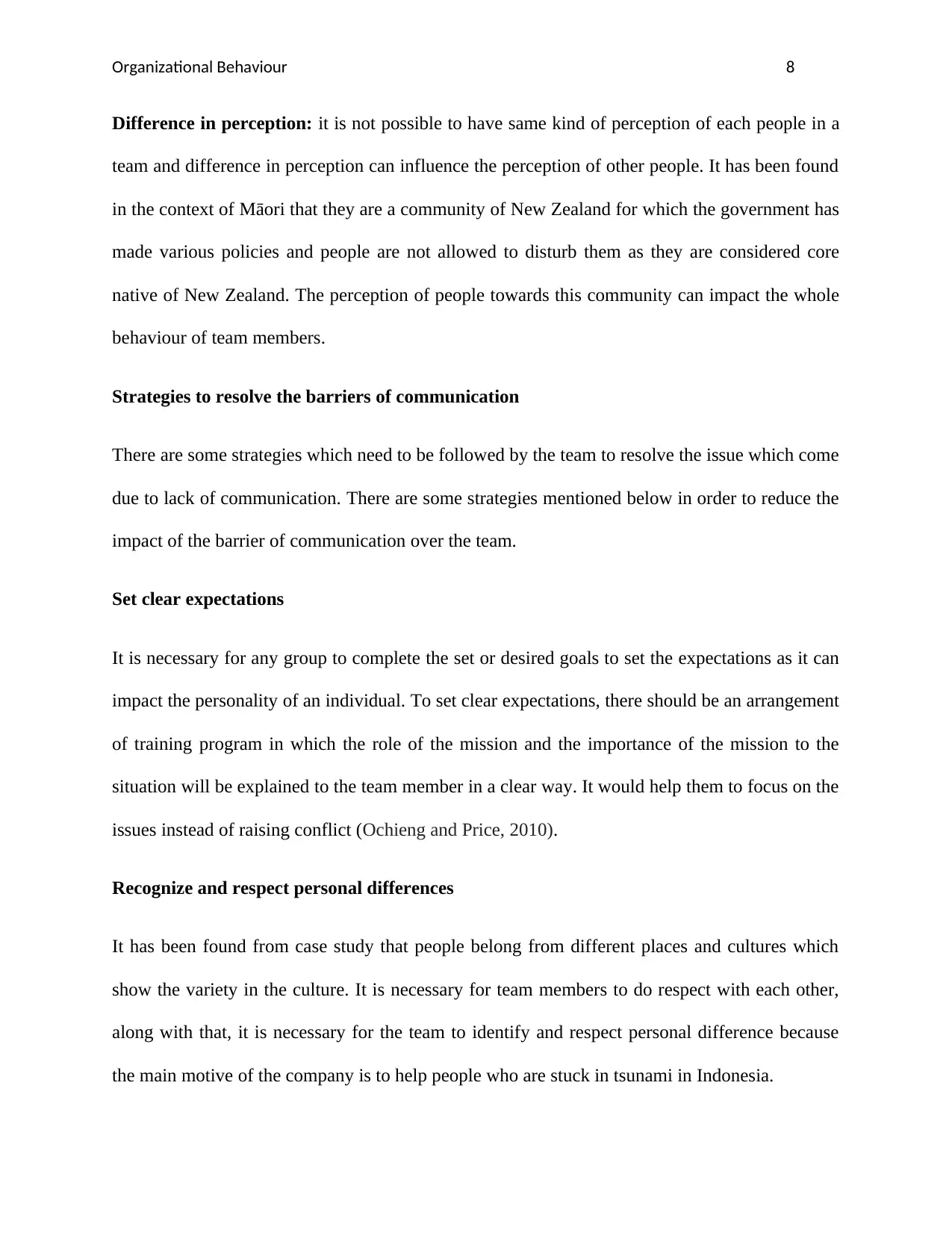
Organizational Behaviour 8
Difference in perception: it is not possible to have same kind of perception of each people in a
team and difference in perception can influence the perception of other people. It has been found
in the context of Māori that they are a community of New Zealand for which the government has
made various policies and people are not allowed to disturb them as they are considered core
native of New Zealand. The perception of people towards this community can impact the whole
behaviour of team members.
Strategies to resolve the barriers of communication
There are some strategies which need to be followed by the team to resolve the issue which come
due to lack of communication. There are some strategies mentioned below in order to reduce the
impact of the barrier of communication over the team.
Set clear expectations
It is necessary for any group to complete the set or desired goals to set the expectations as it can
impact the personality of an individual. To set clear expectations, there should be an arrangement
of training program in which the role of the mission and the importance of the mission to the
situation will be explained to the team member in a clear way. It would help them to focus on the
issues instead of raising conflict (Ochieng and Price, 2010).
Recognize and respect personal differences
It has been found from case study that people belong from different places and cultures which
show the variety in the culture. It is necessary for team members to do respect with each other,
along with that, it is necessary for the team to identify and respect personal difference because
the main motive of the company is to help people who are stuck in tsunami in Indonesia.
Difference in perception: it is not possible to have same kind of perception of each people in a
team and difference in perception can influence the perception of other people. It has been found
in the context of Māori that they are a community of New Zealand for which the government has
made various policies and people are not allowed to disturb them as they are considered core
native of New Zealand. The perception of people towards this community can impact the whole
behaviour of team members.
Strategies to resolve the barriers of communication
There are some strategies which need to be followed by the team to resolve the issue which come
due to lack of communication. There are some strategies mentioned below in order to reduce the
impact of the barrier of communication over the team.
Set clear expectations
It is necessary for any group to complete the set or desired goals to set the expectations as it can
impact the personality of an individual. To set clear expectations, there should be an arrangement
of training program in which the role of the mission and the importance of the mission to the
situation will be explained to the team member in a clear way. It would help them to focus on the
issues instead of raising conflict (Ochieng and Price, 2010).
Recognize and respect personal differences
It has been found from case study that people belong from different places and cultures which
show the variety in the culture. It is necessary for team members to do respect with each other,
along with that, it is necessary for the team to identify and respect personal difference because
the main motive of the company is to help people who are stuck in tsunami in Indonesia.
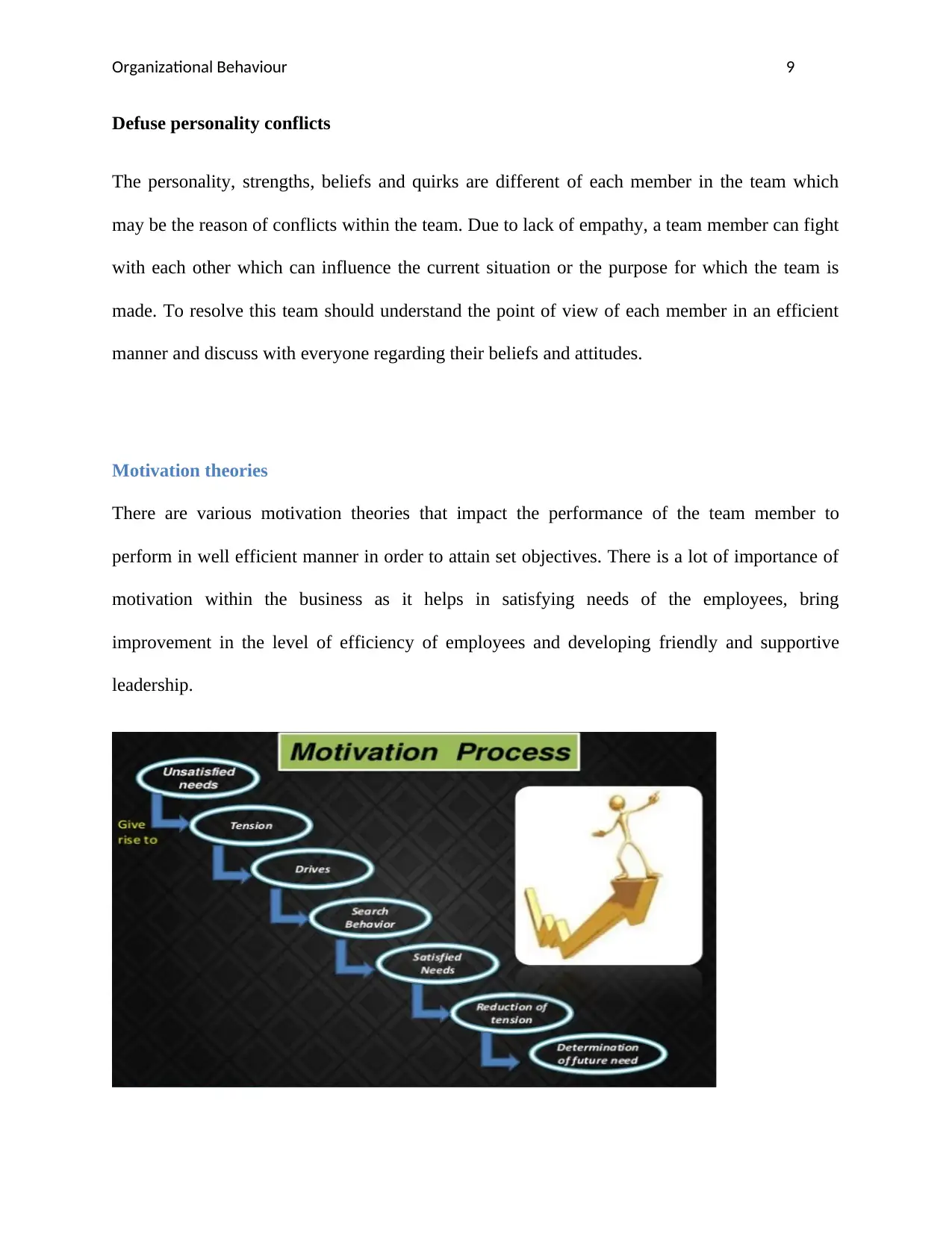
Organizational Behaviour 9
Defuse personality conflicts
The personality, strengths, beliefs and quirks are different of each member in the team which
may be the reason of conflicts within the team. Due to lack of empathy, a team member can fight
with each other which can influence the current situation or the purpose for which the team is
made. To resolve this team should understand the point of view of each member in an efficient
manner and discuss with everyone regarding their beliefs and attitudes.
Motivation theories
There are various motivation theories that impact the performance of the team member to
perform in well efficient manner in order to attain set objectives. There is a lot of importance of
motivation within the business as it helps in satisfying needs of the employees, bring
improvement in the level of efficiency of employees and developing friendly and supportive
leadership.
Defuse personality conflicts
The personality, strengths, beliefs and quirks are different of each member in the team which
may be the reason of conflicts within the team. Due to lack of empathy, a team member can fight
with each other which can influence the current situation or the purpose for which the team is
made. To resolve this team should understand the point of view of each member in an efficient
manner and discuss with everyone regarding their beliefs and attitudes.
Motivation theories
There are various motivation theories that impact the performance of the team member to
perform in well efficient manner in order to attain set objectives. There is a lot of importance of
motivation within the business as it helps in satisfying needs of the employees, bring
improvement in the level of efficiency of employees and developing friendly and supportive
leadership.
⊘ This is a preview!⊘
Do you want full access?
Subscribe today to unlock all pages.

Trusted by 1+ million students worldwide
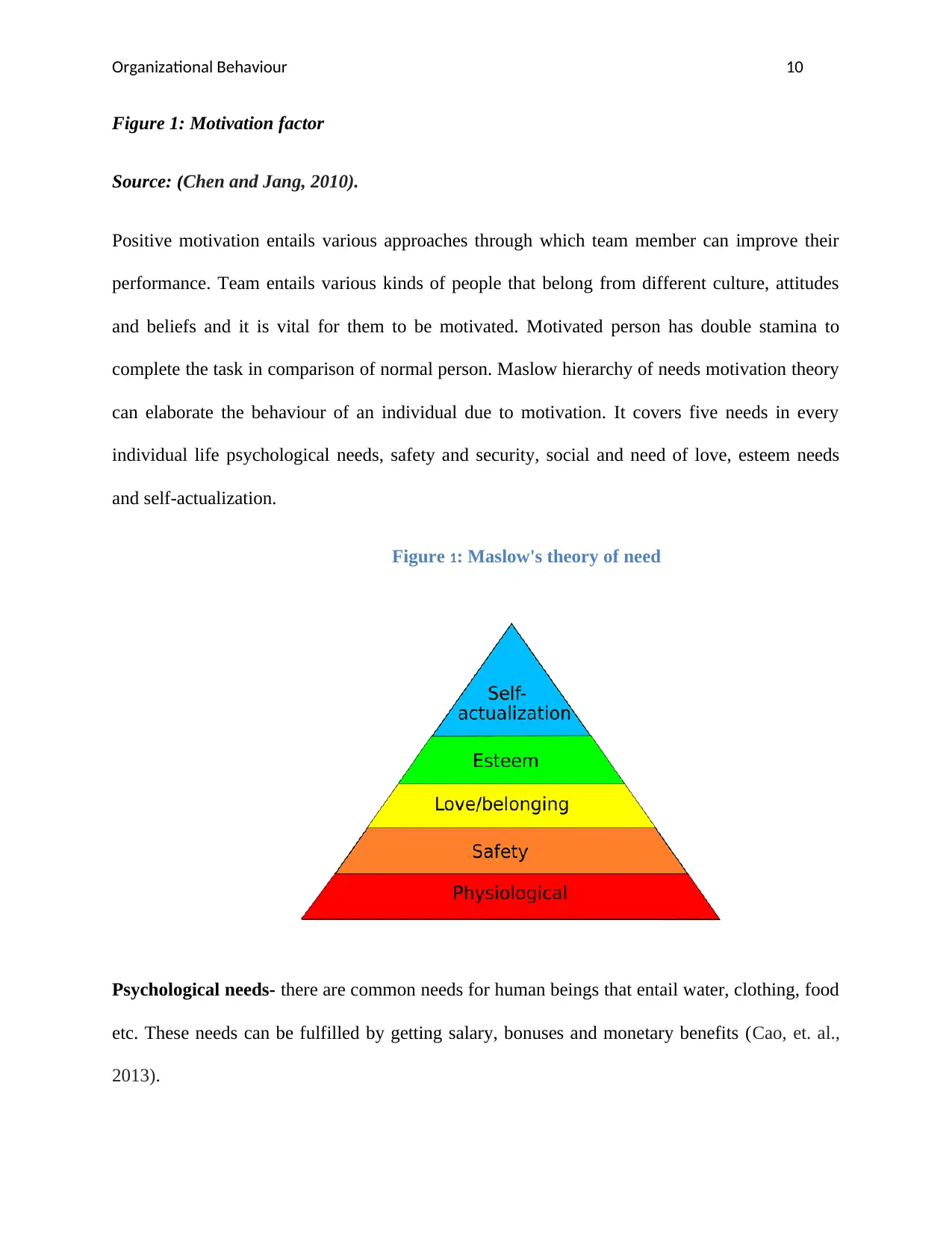
Organizational Behaviour 10
Figure 1: Motivation factor
Source: (Chen and Jang, 2010).
Positive motivation entails various approaches through which team member can improve their
performance. Team entails various kinds of people that belong from different culture, attitudes
and beliefs and it is vital for them to be motivated. Motivated person has double stamina to
complete the task in comparison of normal person. Maslow hierarchy of needs motivation theory
can elaborate the behaviour of an individual due to motivation. It covers five needs in every
individual life psychological needs, safety and security, social and need of love, esteem needs
and self-actualization.
Figure 1: Maslow's theory of need
Psychological needs- there are common needs for human beings that entail water, clothing, food
etc. These needs can be fulfilled by getting salary, bonuses and monetary benefits (Cao, et. al.,
2013).
Figure 1: Motivation factor
Source: (Chen and Jang, 2010).
Positive motivation entails various approaches through which team member can improve their
performance. Team entails various kinds of people that belong from different culture, attitudes
and beliefs and it is vital for them to be motivated. Motivated person has double stamina to
complete the task in comparison of normal person. Maslow hierarchy of needs motivation theory
can elaborate the behaviour of an individual due to motivation. It covers five needs in every
individual life psychological needs, safety and security, social and need of love, esteem needs
and self-actualization.
Figure 1: Maslow's theory of need
Psychological needs- there are common needs for human beings that entail water, clothing, food
etc. These needs can be fulfilled by getting salary, bonuses and monetary benefits (Cao, et. al.,
2013).
Paraphrase This Document
Need a fresh take? Get an instant paraphrase of this document with our AI Paraphraser
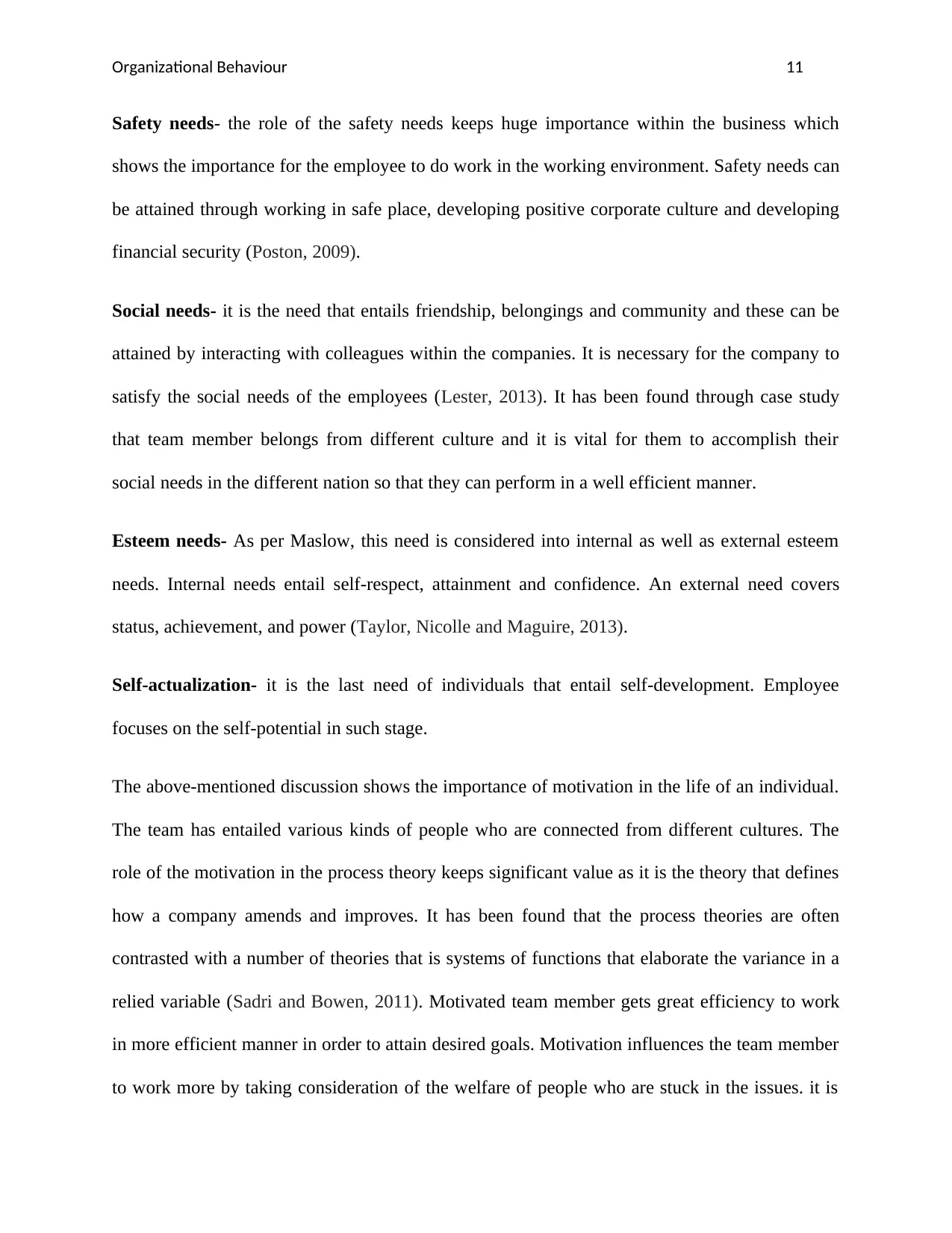
Organizational Behaviour 11
Safety needs- the role of the safety needs keeps huge importance within the business which
shows the importance for the employee to do work in the working environment. Safety needs can
be attained through working in safe place, developing positive corporate culture and developing
financial security (Poston, 2009).
Social needs- it is the need that entails friendship, belongings and community and these can be
attained by interacting with colleagues within the companies. It is necessary for the company to
satisfy the social needs of the employees (Lester, 2013). It has been found through case study
that team member belongs from different culture and it is vital for them to accomplish their
social needs in the different nation so that they can perform in a well efficient manner.
Esteem needs- As per Maslow, this need is considered into internal as well as external esteem
needs. Internal needs entail self-respect, attainment and confidence. An external need covers
status, achievement, and power (Taylor, Nicolle and Maguire, 2013).
Self-actualization- it is the last need of individuals that entail self-development. Employee
focuses on the self-potential in such stage.
The above-mentioned discussion shows the importance of motivation in the life of an individual.
The team has entailed various kinds of people who are connected from different cultures. The
role of the motivation in the process theory keeps significant value as it is the theory that defines
how a company amends and improves. It has been found that the process theories are often
contrasted with a number of theories that is systems of functions that elaborate the variance in a
relied variable (Sadri and Bowen, 2011). Motivated team member gets great efficiency to work
in more efficient manner in order to attain desired goals. Motivation influences the team member
to work more by taking consideration of the welfare of people who are stuck in the issues. it is
Safety needs- the role of the safety needs keeps huge importance within the business which
shows the importance for the employee to do work in the working environment. Safety needs can
be attained through working in safe place, developing positive corporate culture and developing
financial security (Poston, 2009).
Social needs- it is the need that entails friendship, belongings and community and these can be
attained by interacting with colleagues within the companies. It is necessary for the company to
satisfy the social needs of the employees (Lester, 2013). It has been found through case study
that team member belongs from different culture and it is vital for them to accomplish their
social needs in the different nation so that they can perform in a well efficient manner.
Esteem needs- As per Maslow, this need is considered into internal as well as external esteem
needs. Internal needs entail self-respect, attainment and confidence. An external need covers
status, achievement, and power (Taylor, Nicolle and Maguire, 2013).
Self-actualization- it is the last need of individuals that entail self-development. Employee
focuses on the self-potential in such stage.
The above-mentioned discussion shows the importance of motivation in the life of an individual.
The team has entailed various kinds of people who are connected from different cultures. The
role of the motivation in the process theory keeps significant value as it is the theory that defines
how a company amends and improves. It has been found that the process theories are often
contrasted with a number of theories that is systems of functions that elaborate the variance in a
relied variable (Sadri and Bowen, 2011). Motivated team member gets great efficiency to work
in more efficient manner in order to attain desired goals. Motivation influences the team member
to work more by taking consideration of the welfare of people who are stuck in the issues. it is
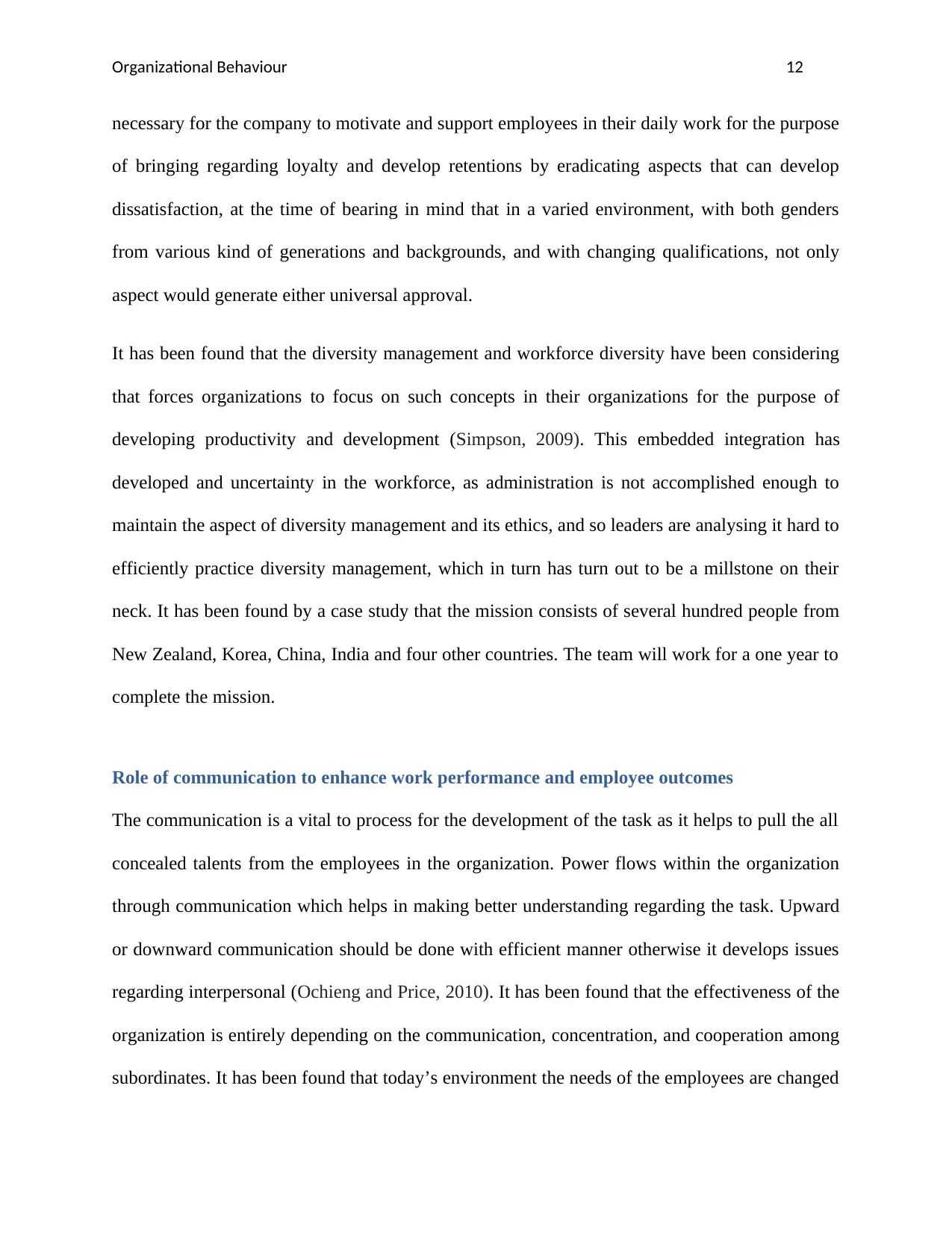
Organizational Behaviour 12
necessary for the company to motivate and support employees in their daily work for the purpose
of bringing regarding loyalty and develop retentions by eradicating aspects that can develop
dissatisfaction, at the time of bearing in mind that in a varied environment, with both genders
from various kind of generations and backgrounds, and with changing qualifications, not only
aspect would generate either universal approval.
It has been found that the diversity management and workforce diversity have been considering
that forces organizations to focus on such concepts in their organizations for the purpose of
developing productivity and development (Simpson, 2009). This embedded integration has
developed and uncertainty in the workforce, as administration is not accomplished enough to
maintain the aspect of diversity management and its ethics, and so leaders are analysing it hard to
efficiently practice diversity management, which in turn has turn out to be a millstone on their
neck. It has been found by a case study that the mission consists of several hundred people from
New Zealand, Korea, China, India and four other countries. The team will work for a one year to
complete the mission.
Role of communication to enhance work performance and employee outcomes
The communication is a vital to process for the development of the task as it helps to pull the all
concealed talents from the employees in the organization. Power flows within the organization
through communication which helps in making better understanding regarding the task. Upward
or downward communication should be done with efficient manner otherwise it develops issues
regarding interpersonal (Ochieng and Price, 2010). It has been found that the effectiveness of the
organization is entirely depending on the communication, concentration, and cooperation among
subordinates. It has been found that today’s environment the needs of the employees are changed
necessary for the company to motivate and support employees in their daily work for the purpose
of bringing regarding loyalty and develop retentions by eradicating aspects that can develop
dissatisfaction, at the time of bearing in mind that in a varied environment, with both genders
from various kind of generations and backgrounds, and with changing qualifications, not only
aspect would generate either universal approval.
It has been found that the diversity management and workforce diversity have been considering
that forces organizations to focus on such concepts in their organizations for the purpose of
developing productivity and development (Simpson, 2009). This embedded integration has
developed and uncertainty in the workforce, as administration is not accomplished enough to
maintain the aspect of diversity management and its ethics, and so leaders are analysing it hard to
efficiently practice diversity management, which in turn has turn out to be a millstone on their
neck. It has been found by a case study that the mission consists of several hundred people from
New Zealand, Korea, China, India and four other countries. The team will work for a one year to
complete the mission.
Role of communication to enhance work performance and employee outcomes
The communication is a vital to process for the development of the task as it helps to pull the all
concealed talents from the employees in the organization. Power flows within the organization
through communication which helps in making better understanding regarding the task. Upward
or downward communication should be done with efficient manner otherwise it develops issues
regarding interpersonal (Ochieng and Price, 2010). It has been found that the effectiveness of the
organization is entirely depending on the communication, concentration, and cooperation among
subordinates. It has been found that today’s environment the needs of the employees are changed
⊘ This is a preview!⊘
Do you want full access?
Subscribe today to unlock all pages.

Trusted by 1+ million students worldwide
1 out of 20
Related Documents
Your All-in-One AI-Powered Toolkit for Academic Success.
+13062052269
info@desklib.com
Available 24*7 on WhatsApp / Email
![[object Object]](/_next/static/media/star-bottom.7253800d.svg)
Unlock your academic potential
Copyright © 2020–2025 A2Z Services. All Rights Reserved. Developed and managed by ZUCOL.





